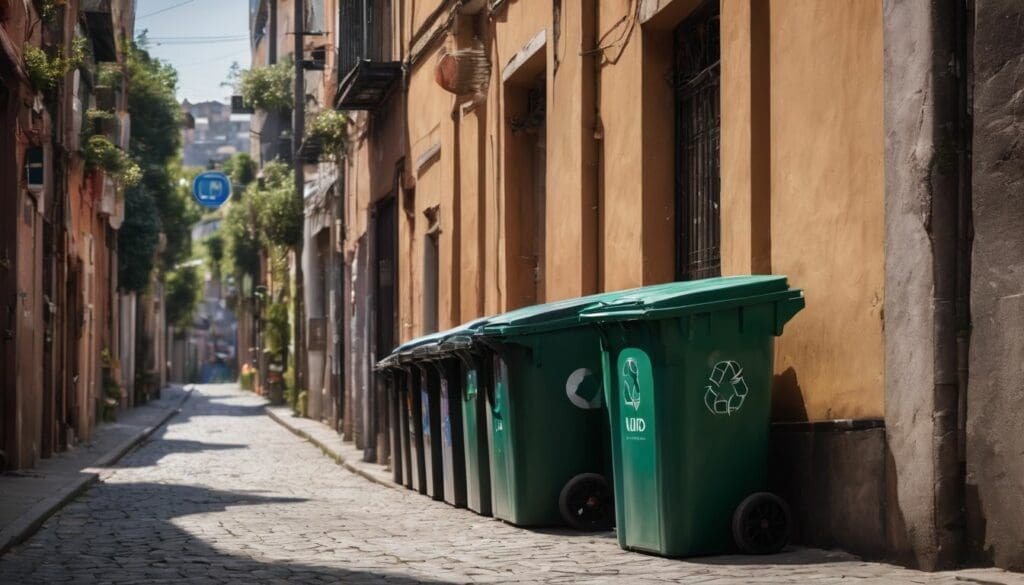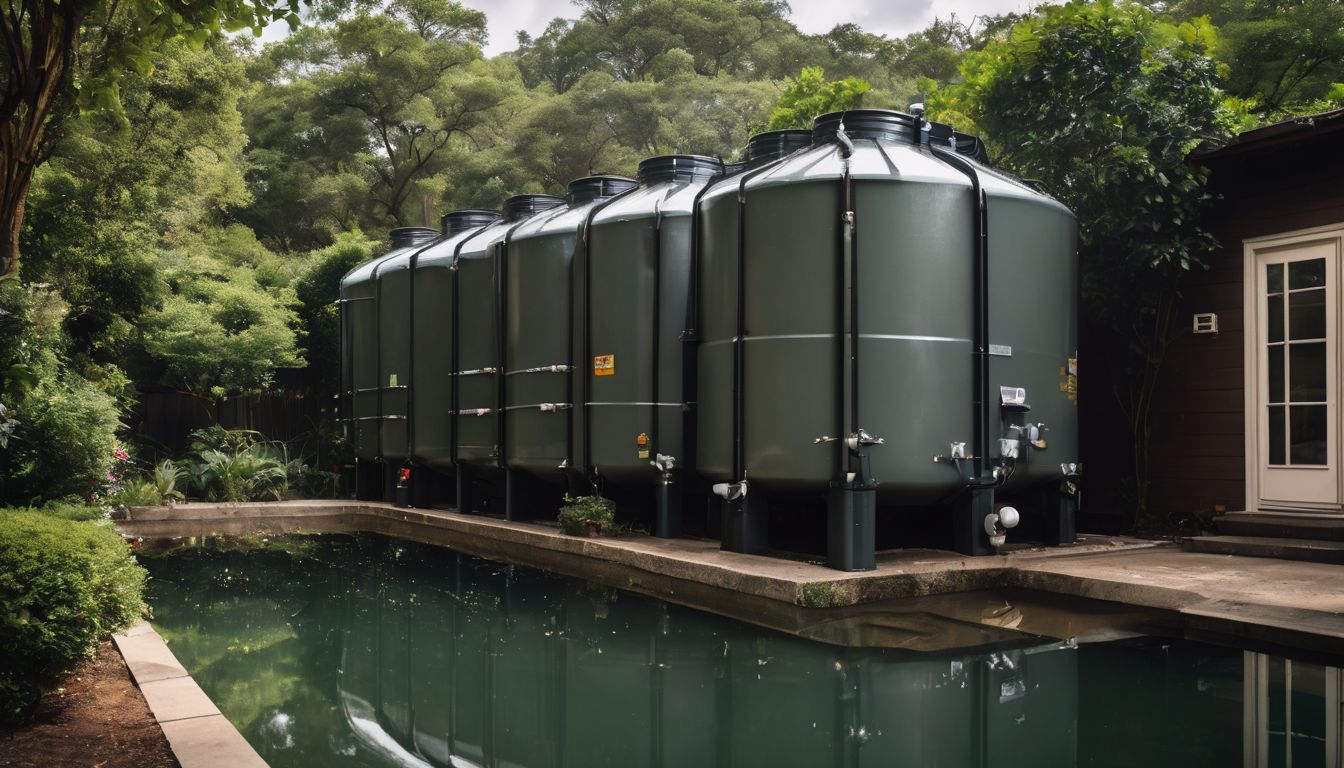Staring at your overflowing bins, you wonder how to tackle the waste problem in your neighbourhood. Each year, millions of tonnes of recyclable materials end up in landfills when they could be reused.
We’re here to guide you through starting a successful neighborhood recycling program that will turn trash into treasure and keep our environment clean. Let’s make recycling second nature!
Key Takeaways
- Assign a dedicated Recycling Coordinator to oversee the recycling program and educate the community about sustainable waste management practices.
- Identify what types of materials can be recycled locally, including paper, cardboard, glass, plastics, metals, and electronics. Check with regional facilities for specific recycling guidelines.
- Choose suitable collection methods such as curbside pickup or drop-off centres based on the community’s needs and implement clear sorting instructions to minimise contamination.
- Promote the program through public education using workshops, social media campaigns and collaboration with schools to raise awareness about environmental conservation.
- Monitor and assess your recycling initiative regularly by tracking progress, gathering feedback from residents, and making necessary improvements for future success.
Understanding the Importance of Recycling
Recycling is vital for reducing waste and preserving natural resources. It helps to conserve energy, reduce pollution, and minimise the strain on landfills. Plus, many materials like paper, glass, plastic, and aluminium can be recycled multiple times.
Why recycle?
Recycling turns materials that would otherwise become waste into valuable resources, thereby creating a loop of sustainable practice. It’s a powerful act of environmental conservation that reduces the need for new raw materials, cuts down greenhouse gas emissions and saves energy.
Through resource recovery, communities contribute to combating climate change and conserving natural habitats by minimising the strain on landfills and reducing pollution.
Every bottle, paper or can recycled is a step towards greener living, making neighbourhood recycling programmes pivotal in fostering ecofriendly practices. As society pushes for more sustainable development, individual actions within a community accumulate to make meaningful impact.
Engaging in such initiatives not only protects the planet but also sets an example of environmental stewardship for future generations.
What can be recycled?
After understanding why recycling is important, it’s crucial to know what can be recycled in your neighbourhood programme. Here’s a detailed breakdown of items that are commonly recyclable:
- Paper: Envelopes, newspapers, magazines, office paper, cereal boxes
- Cardboard: Boxes from household items and packaging materials
- Glass: Bottles and jars
- Plastics: Containers with numbers 1-7, such as beverage bottles, food containers, and detergent bottles
- Metals: Aluminium cans, steel cans, tin foil, and empty aerosol cans
- Electronics: Old computers, televisions, printers
Preliminary Planning for a Community Recycling Program
Designate a Recycling Coordinator to spearhead the initiative and survey current waste operations. Identify markets for recyclable materials before moving on to design your program.
Designate a Recycling Coordinator
Assigning a Recycling Coordinator is crucial to the success of your neighbourhood recycling program. This role involves overseeing the collection and processing of recyclables, coordinating with local authorities and waste management facilities, as well as educating residents about recycling practices.
The chosen individual should have strong organisational skills, be passionate about environmental sustainability, and able to communicate effectively with the community.
Appointing a proactive Recycling Coordinator can ensure that your programme runs smoothly and fosters active community participation. They will be responsible for coordinating collection logistics, ensuring proper disposal of materials, and organising educational initiatives to promote recycling awareness in the neighbourhood.
Survey current waste operations
Assess waste operations in your community to understand the current disposal methods and identify potential areas for improvement. Understand the types of waste being generated, how it is collected, and where it goes.
Analyse the effectiveness of existing waste management practices and look for opportunities to integrate recycling initiatives into the current system. Evaluate local government involvement and explore potential partnerships to enhance sustainable practices within the community.
By gaining insight into current waste operations, you can develop a tailored neighbourhood recycling programme that aligns with existing processes while promoting eco-friendly initiatives.
Identify markets for materials
Consider local businesses and industries that may purchase the recycled materials. Research manufacturers who use recycled materials in their production processes. Check for any existing agreements with recycling companies, or explore potential partnerships with nearby municipalities or waste management facilities.
Engage in dialogues with community stakeholders to brainstorm opportunities for sustainably selling the collected recyclables.
Investigate potential markets for the materials through networking and research partnerships within your community, hold discussions about potential buyers of the recyclable goods, strategise on leveraging these relationships to reinforce a sustainable recycling programme.
Designing Your Recycling Program
Determine the best collection methods for your neighborhood, considering factors like curbside pickup or drop-off locations. Define what equipment will be needed and consider partnering with regional recycling facilities to ensure the success of your program.
Determine collection methods
Consider the collection methods for your neighbourhood recycling programme. Ensure that you choose the most suitable method based on the type and quantity of recyclables generated within your community.
Explore options such as curbside pickup, drop-off centres, or a combination of both to maximise participation and convenience for residents. Collaborate with waste management authorities to establish an efficient collection schedule that meets the needs of your programme and supports sustainable waste reduction efforts in your neighbourhood.
Evaluate the feasibility of implementing separate collection streams for different types of materials including paper, plastic, glass, and metal. Aim to streamline the process by providing clear guidelines on how items should be sorted and prepared for collection.
Define equipment requirements
When designing a neighbourhood recycling programme, it is essential to define the equipment requirements. Recycling bins, collection vehicles, sorting equipment, and storage facilities are key components needed for an efficient programme.
The type and quantity of equipment will depend on the size of the community and the volume of recyclable materials generated. It’s important to choose durable and user-friendly bins that are easily accessible to residents while ensuring that collection vehicles are suitable for transporting recyclables to processing facilities.
Considering regional recycling options can also influence the selection of equipment. Understanding available markets for recycled materials in your area will help determine the type and capacity of sorting equipment required.
Moreover, identifying local material recovery facilities or other recycling partners can impact storage needs as well as transportation logistics. By defining equipment requirements based on these factors, you can establish a comprehensive neighbourhood recycling programme.
Consider regional recycling
When designing your recycling programme, it’s essential to consider regional recycling facilities and their capabilities. Research local recycling options to understand what materials can be recycled in your area.
Engage with regional waste management authorities to ensure alignment with their processes, regulations and best practices. By considering regional recycling, you can optimise the efficiency of your neighbourhood programme while contributing to sustainable waste management.
Moving on to “Operating Your Programme,” learn how you can effectively conduct public education and publicity for maximum impact.
Operating Your Program
Promote recycling through public education and publicity, monitor and evaluate the program regularly to ensure its success, and focus on sustainable practices for the future. If you want to learn more about how to operate a successful neighborhood recycling program, keep reading!
Conduct public education and publicity
To effectively promote your neighbourhood recycling programme, educate the community about the importance of recycling and how it contributes to community sustainability. Engage residents through educational outreach efforts and promotional activities. Utilise various platforms such as social media, local events, and community meetings to raise awareness about the benefits of recycling and the impact it has on eco-friendly living.
- Host workshops or seminars to provide information on the recycling collection plan and how community involvement can lead to a more sustainable neighbourhood.
- Collaborate with local schools and institutions to organise educational programmes that focus on recycling facts promotion, emphasising the positive effect of green living.
- Partner with local businesses and organisations to support eco – friendly programmes, allowing for a wider reach and greater impact within the community.
- Implement visually engaging signage throughout the neighbourhood to encourage residents to participate in neighbourhood cleanup efforts and practise responsible waste management.
- Distribute informative materials such as brochures or flyers that outline the benefits of recycling and provide practical tips for effective waste management.
Monitor and evaluate the program
To effectively assess the impact of your recycling programme, regular monitoring and evaluation are essential. Start by collecting data on the amount and types of materials being recycled.
Analyse this information to identify areas for improvement and track progress towards your goals.
Additionally, gather feedback from participants to understand their experience with the programme and any suggestions they may have. Use this insight to make adjustments that enhance the effectiveness of your neighbourhood recycling initiative.
Look towards the future
To ensure the long-term success of your neighbourhood recycling programme, consider future expansions and adjustments. As the community’s recycling habits evolve, keep an eye on emerging technologies and trends in waste management.
This proactive approach will allow you to adapt the programme according to changing needs and advancements in eco-friendly practices.
By staying abreast of new developments, you can position your initiative as a frontrunner in sustainable neighbourhood waste management. Stay connected with local environmental organisations and authorities to remain informed about potential policy changes or funding opportunities that could support the growth of your recycling programme.
Tips for a Successful Neighborhood Recycling Program
– Starting in a single-family home neighborhood, consider hosting a community meeting to discuss the benefits and logistics of recycling. Implementing in an HOA community may require approval from the board, so be sure to present a well-thought-out plan.
When it comes to recycling in apartment or condominium complexes, work with property managers to provide convenient recycling options for residents. Encouraging residents to recycle can be as simple as providing educational materials and reminders about the program’s impact on the environment.
Lastly, educate the community about the program through flyers, social media posts, and word-of-mouth communication.
Starting in a single-family home neighborhood
Begin your neighbourhood recycling programme by reaching out to your neighbours in a single-family home community. Emphasise the benefits of recycling and enlist their support to kickstart the initiative.
Host informational sessions or distribute educational materials to raise awareness about the importance of recycling and its positive impact on the environment. Collaborate with local authorities or waste management companies to establish collection points for recyclable materials within the neighbourhood, making it convenient for residents to participate in the programme.
Once you have garnered interest and support from your neighbours, designate a dedicated area for collecting recyclables, set up bins, and clearly label them. Create a schedule for regular pickups or drop-offs at local recycling centres, ensuring that participation remains consistent.
Implementing in an HOA community
HOA communities present a unique opportunity to implement recycling programmes due to their centralised management structure. With the support of the HOA board, you can initiate a comprehensive recycling programme that involves all residents.
Begin by collaborating with the board to establish clear guidelines for sorting and collecting recyclables, and designate specific areas within the community for recycling bins. It’s important to educate homeowners about the benefits of recycling and ensure that they understand how to properly participate in the programme.
To encourage participation, consider organising workshops or informational sessions specifically tailored for HOA members. Additionally, leverage digital communication channels such as email newsletters or community forums to regularly remind residents about the importance of recycling and provide updates on the programme’s progress.
Recycling in apartment or condominium complexes
Apartment and condominium complexes can implement recycling programs by providing designated areas for sorting recyclable materials. Residents should be educated about the types of items that can be recycled to ensure proper disposal.
Implementing a system for regular collection, such as scheduling pickups or setting up drop-off points, is essential for the program’s success.
Encouraging participation through informational campaigns and incentives is crucial in promoting sustainable habits among residents. Regular monitoring of the recycling program will help identify any challenges and opportunities for improvement, ensuring its long-term viability within the community.
Encouraging residents to recycle
Encouraging residents to recycle starts with providing clear and accessible recycling bins in communal areas. Create educational materials on what can be recycled and how to do it correctly, such as leaflets or posters, for widespread distribution.
Organise community events promoting the benefits of recycling and provide practical tips for integrating recycling into daily routines.
Make sure that information about your neighbourhood recycling programme is easily available, through social media, newsletters or community websites. Offering incentives like rewards or recognition for active participants can also help foster enthusiasm for the initiative.
Educating the community about the program
Once residents are on board with recycling, the next step is educating the wider community about the programme. Spread awareness through local events and social media, emphasising the benefits of recycling for a healthier environment.
Offer workshops to demonstrate how to properly sort recyclables and provide educational materials in multiple languages to ensure inclusivity.
By engaging local schools and community organisations, you can encourage participation and instil a sense of responsibility towards conservation. Workshops on reducing waste, reusing items, and repurposing materials will further empower individuals to take an active role in protecting the environment.
Conclusion
Starting a neighborhood recycling program may seem daunting, but with careful planning and community involvement, it is achievable. Engaging residents in the importance of recycling through education and awareness is crucial to the success of the program.
Implementing simple yet effective strategies can lead to a sustainable and eco-friendly solution for managing waste within your local area. Taking initiative now can pave the way for a cleaner and healthier environment for future generations.
FAQs
1. What are the first steps to start a neighbourhood recycling programme?
To launch an ecofriendly neighbourhood recycling programme, begin by gathering a team, educating your community about recycling, and setting up clear guidelines.
2. How can we educate our community about the benefits of recycling?
Organise local meetings, distribute informative materials, and host workshops to spread knowledge on how recycling helps the environment.
3. What should we consider when setting up a local recycling scheme?
Consider choosing convenient locations for recycling bins, determining what materials can be recycled, and establishing a schedule for collection.
4. Who might help us manage our neighbourhood’s new recycling initiative?
Reach out to local authorities or environmental organisations; they often offer support and resources for starting ecofriendly programmes like neighbourhood recycling.





